La Dame aux Camélias
La Dame aux Camélias (literally The Lady with the Camellias, commonly known in English as Camille) is a novel by Alexandre Dumas fils, first published in 1848 and subsequently adapted by Dumas for the stage. La Dame aux Camélias premiered at the Théâtre du Vaudeville in Paris, France on February 2, 1852. The play was an instant success, and Giuseppe Verdi immediately set about putting the story to music. His work became the 1853 opera La traviata, with the female protagonist, Marguerite Gautier, renamed Violetta Valéry.
| The Lady of the Camellias | |
|---|---|
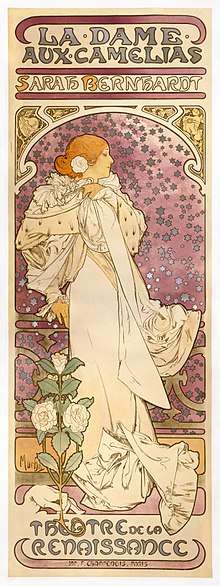 Alphonse Mucha's poster for a performance of the theatrical version, with Sarah Bernhardt (1896) | |
| Written by | Alexandre Dumas, fils |
| Date premiered | 2 February 1852 |
| Place premiered | Théâtre du Vaudeville, Paris, France |
| Original language | French |
| Genre | Drama |
In the English-speaking world, La Dame aux Camélias became known as Camille and 16 versions have been performed at Broadway theatres alone. The title character is Marguerite Gautier, who is based on Marie Duplessis, the real-life lover of author Dumas, fils.[1]
Summary and analysis
.jpg)

Written by Alexandre Dumas fils (1824–1895) when he was 23 years old, and first published in 1848, La Dame aux Camélias is a semi-autobiographical novel based on the author's brief love affair with a courtesan, Marie Duplessis. Set in mid-19th-century France, the novel tells the tragic love story between fictional characters Marguerite Gautier, a demimondaine or courtesan suffering from consumption, and Armand Duval, a young bourgeois.[2] Marguerite is nicknamed la dame aux camélias (French for ''the lady of the camellias'') because she wears a red camellia when she is menstruating and unavailable for making love and a white camelia when she is available to her lovers.[3]
Armand falls in love with Marguerite and ultimately becomes her lover. He convinces her to leave her life as a courtesan and to live with him in the countryside. This idyllic existence is interrupted by Armand's father, who, concerned with the scandal created by the illicit relationship, and fearful that it will destroy Armand's sister's chances of marriage, convinces Marguerite to leave. Until Marguerite's death, Armand believes that she left him for another man. Marguerite's death is described as an unending agony, during which Marguerite, abandoned by everyone, regrets what might have been.[3]
The story is narrated after Marguerite's death by two men, Armand and an unnamed frame narrator. Some scholars believe that both the fictional Marguerite's illness and real life Duplessis's publicized cause of death, "consumption", was a 19th-century euphemism for syphilis[2], as opposed to the more common meaning of tuberculosis. Dumas, fils, is careful to paint a favourable portrait of Marguerite, who despite her past is rendered virtuous by her love for Armand, and the suffering of the two lovers, whose love is shattered by the need to conform to the morals of the times, is rendered touchingly. In contrast to the Chevalier des Grieux's love for Manon in Manon Lescaut (1731), a novel by Abbé Prévost referenced at the beginning of La Dame aux Camélias, Armand's love is for a woman who is ready to sacrifice her riches and her lifestyle for him, but who is thwarted by the arrival of Armand's father. The novel is also marked by the description of Parisian life during the 19th century and the fragile world of the courtesan.
Stage performances

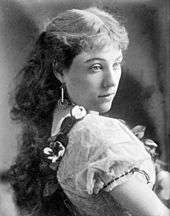

Dumas wrote a stage adaptation that premiered February 2, 1852, at the Théâtre du Vaudeville in Paris. Eugénie Doche created the role of Marguerite Gautier, opposite Charles Fechter as Armand Duval. "I played the role 617 times," Doche recalled not long before her death in 1900, "and I suppose I could not have played it very badly, since Dumas wrote in his preface, 'Mme. Doche is not my interpreter, she is my collaborator'."[4]
In 1853, Jean Davenport starred in the first United States production of the play, a sanitized version that changed the name of the leading character to Camille—a practice adopted by most American actresses playing the role.[5]:115
The role of the tragic Marguerite Gautier became one of the most coveted amongst actresses and included performances by Sarah Bernhardt, Laura Keene, Eleonora Duse, Margaret Anglin, Gabrielle Réjane, Tallulah Bankhead, Lillian Gish, Dolores del Río, Eva Le Gallienne, Isabelle Adjani, Cacilda Becker, and Helena Modrzejewska. Bernhardt quickly became associated with the role after starring in Camellias in Paris, London, and several Broadway revivals, plus the 1911 film. Dancer/Impresario Ida Rubinstein successfully recreated Bernhardt's interpretation of the role onstage in the mid-1920s, coached by the great actress herself before she died.
Of all Dumas, fils's theatrical works, La Dame aux Camélias is the most popular around the world. In 1878 Scribner's Monthly reported that "not one other play by Dumas, fils has been received with favor out of France".[6]
Adaptations
Opera
.jpg)
The success of the play inspired Giuseppe Verdi to put the story to music. His work became the 1853 opera La traviata, set to an Italian libretto by Francesco Maria Piave. The female protagonist, Marguerite Gautier, is renamed Violetta Valéry.
Film

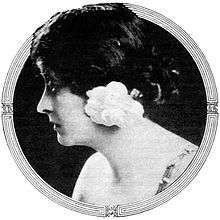
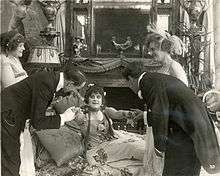
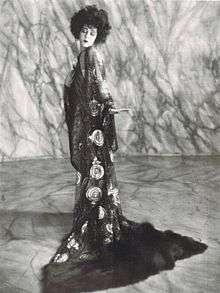
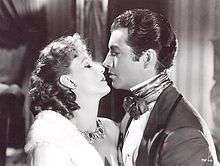
La Dame aux Camélias has been adapted for some 20 different motion pictures in numerous countries and in a wide variety of languages. The role of Marguerite Gautier has been played on screen by Sarah Bernhardt, María Félix, Clara Kimball Young, Theda Bara, Yvonne Printemps, Alla Nazimova, Greta Garbo, Micheline Presle, Francesca Bertini, Isabelle Huppert, and others.
Films entitled Camille
There have been at least nine adaptations of La Dame aux Camélias entitled Camille.
- Camille (1915), an American silent film adapted by Frances Marion, directed by Albert Capellani, starring Clara Kimball Young as Camille and Paul Capellani as Armand
- Camille (1917), an American silent film adapted by Adrian Johnson, directed by J. Gordon Edwards, starring Theda Bara as Camille and Alan Roscoe as Armand
- Camille (1921), an American silent film starring Alla Nazimova as Camille and Rudolph Valentino as Armand
- Camille (1926), an American silent film directed by Fred Niblo, starring Norma Talmadge as Camille and Gilbert Roland as Armand
- Camille: The Fate of a Coquette (1926), an American short film by Ralph Barton, compiled from his home movies, loosely based on La Dame aux Camélias
- Camille (1936), an American film directed by George Cukor, starring Greta Garbo as Camille and Robert Taylor as Armand
- Camille 2000 (1969), an Italian film adapted by Michael DeForrest, directed by Radley Metzger, starring Danielle Gaubert as Marguerite and Nino Castelnuovo as Armand
- Camille (1981), commonly known as La Dame aux Camélias or Lady of the Camellias (Italian: La storia vera della signora dalle camelie, lit. 'the true story of the lady of the camellias'), a French-Italian film directed by Mauro Bolognini, starring Isabelle Huppert as Alphonsine
- Camille (1984), a television film adapted by Blanche Hanalis, directed by Desmond Davis, starring Greta Scacchi as Camille and Colin Firth as Armand
Other films based on La Dame aux Camélias
In addition to the Camille films, the story has been the adapted into numerous other screen versions:
- Kameliadamen, the first movie based on the work. Kameliadamen was a 1907 Danish silent film directed by Viggo Larsen and starring Oda Alstrup, Larsen, Gustave Lund and Robert Storm Petersen.
- La Dame aux Camélias, a 1911 French-language silent film, directed by André Calmettes and Henri Pouctal. It stars Sarah Bernhardt, Lou Tellegen and Paul Capellani.
- La Signora delle Camelie, a 1915 Italian-language silent film. It was directed by Baldassarre Negroni. It stars Hesperia, Alberto Collo and Ida Carloni Talli.
- La Signora delle Camelie, a 1915 Italian-language silent film. It was directed by Gustavo Serena. It stars Francesca Bertini and Serena.
- Arme Violetta (1920), a German-language silent film starring Pola Negri.
- Damen med kameliorna, a 1925 Swedish-language film adapted and directed by Olof Molander, starring Uno Henning and Tora Teje.
- La Dame aux Camélias (1934), the first sound adaptation, was a French-language film adapted by Abel Gance and directed by Gance and Fernand Rivers. It starred Yvonne Printemps and Pierre Fresnay.
- A 1944 Spanish-language version was produced in Mexico. It was adapted by Roberto Tasker, directed by Gabriel Soria, and starred Lina Montes and Emilio Tuero.
- A 1947 Italian version The Lady of the Camellias directed by Carmine Gallone and starring Nelly Corradi
- La Dame aux Camélias, a 1953 French-language film adapted by Jacques Natanson and directed by Raymond Bernard, starring Gino Cervi, Micheline Presle and Roland Alexandre.
- Traviata '53, a 1953 Italian-language film adapted and directed by Vittorio Cottafavi, starring Barbara Laage, Armando Francioli and Eduardo De Filippo.
- Camelia, a 1954 Mexican film directed by Roberto Gavaldón, and stars María Félix.
- La mujer de las camelias, a 1954 Argentine film adapted by Alexis de Arancibia (as Wassen Eisen) and Ernesto Arancibia, and directed by Ernesto Arancibia. It stars Zully Moreno.
- Kamelyalı Kadın, 1957 Turkish film starring Çolpan İlhan.[7]
- The Lady of the Camellias, a 1976 UK television serial, starring Kate Nelligan.
- La Dame aux Camélias, a 1981 French-language film adapted by Jean Aurenche, Enrico Medioli and Vladimir Pozner, and directed by Mauro Bolognini, starring Isabelle Huppert.
- Dama Kameliowa, a 1994 Polish-language film
- Moulin Rouge! (2001), directed by Baz Luhrmann, starring Nicole Kidman and Ewan McGregor.
Scrapped Franco Zeffirelli adaption
In her 2018 memoir, Olivia Hussey revealed that in the late 1960s/early 1970s, Franco Zeffirelli had intended to do a new film adaptation of Camille with Hussey playing the lead role of Marguerite Gautier.
Zeffirelli first approached Hussey about starring in the film a few weeks after the premiere of Romeo and Juliet (1968). He sent her a copy of the original book with a note that said “You are my Marguerite Gautier”.[8] The two year long publicity tour for Romeo and Juliet (1968), stalled the project as Hussey and Zeffirelli traveled the world to promote the film. After the tour, Zeffirelli had trouble finding finances and a studio for the project. Meanwhile, Hussey starred in All The Right Noises (1971), got out of an abusive relationship with Christopher Jones, and later married Dean Paul Martin in 1971.
In 1972, Zeffirelli directed the film, Brother Sun Sister Moon (1972), which failed to live up to the success of Romeo and Juliet (1968), and prevented him from finding a studio to pick his proposal for Camille. Hussey, believing that the film was off, starred in Summertime Killer (1972) and Lost Horizon (1973), and had her first child in February of 1973.
Zeffirelli tried one last time to get the film picked up in late 1973, but this time without Hussey. Given the overwhelming negative reception of Hussey’s recent film, Lost Horizon, she wasn’t seen as the same box office draw as she was a few years earlier. Unbeknownst to Hussey, Zeffirelli recruited recent Oscar winner (and best friend to Hussey), Liza Minnelli, for the role of Marguerite Gautier. Even with Minnelli’s Oscar winning name attached to the proposal, no studio showed interest in the project.
For blindsiding her, Hussey’s relationship with Zeffirelli and Minnelli tumbled for sometime (particularly with Liza). Olivia said of the situation “I was stunned. Liza and I would often talk about work, and I had told her how excited I was to play Marguerite Gautier. How it was the role of a lifetime, and how Franco would bring it to life. I had said that he was a genius and I loved him and that he was adapting the work with me in mind. It was like I was handing it to her, the way I described it. I felt betrayed. I understood that having an Oscar-winning name like Liza’s attached would help Franco get the picture made. Directors, in my experience, will do anything to get a project off the ground, and I really couldn’t blame him (although in my heart I did). But Liza? How could she go behind my back like that? She wouldn’t even have known about Camille if I hadn’t talked it up.”[8]
Franco Zeffirelli’s vision of Camille ultimately never came to fruition. Olivia would later rekindle her relationship with Franco, and even reunited with him for the film Jesus of Nazareth a few years later.
On the other hand, her relationship with Minnelli didn’t have the same mending. Hussey recalled “she called from Rome to apologize and smooth things over. It was big of her, but I found myself being nasty, telling her that Franco must be thinking of doing the film as a comedy if he were willing to cast her in the role. It was a terrible thing to say, and I felt awful afterward, but I was hurt and angry...Liza and I did find our way back to being friends, although it was never quite the same.”[8]
Ballet
- Lady of the Camellias is a ballet by John Neumeier with music by Frédéric Chopin, created for Marcia Haydée, then prima ballerina of the Stuttgart Ballet. It premiered at the Staatstheater Stuttgart in 1978.[9]
- Lady of the Camellias is a ballet by Val Caniparoli with music by Frédéric Chopin. It premiered with Ballet Florida at the Raymond Kravis Center in 1994.
- Marguerite and Armand is an adaptation created in 1963 by renowned choreographer Sir Frederick Ashton specifically for Rudolf Nureyev and prima ballerina assoluta Dame Margot Fonteyn.
- Veronica Paeper created a ballet Camille based on The Lady of the Camellias which has been staged several times since 1990.[10]
Stage
Amongst many adaptations, spin-offs, and parodies, was Camille, "a travesty on La Dame aux Camellias by Charles Ludlam, staged first by his own Ridiculous Theatrical Company in 1973, with Ludlam playing the lead in drag.[11]
In 1999 Alexia Vassiliou collaborated with composer Aristides Mytaras for the contemporary dance performance, La Dame aux Camélias at the Amore Theatre in Athens.
It is also the inspiration for the 2008 musical Marguerite,[12] which places the story in 1944 German-occupied France.
Novels
In My Ántonia by Willa Cather, the characters Jim Burden and Lena Lingard are much moved by a theatrical production of Camille, which they attend in book 3, chapter 3. Love Story, published by Eric Segal in 1970, has essentially the same plot updated to contemporary New York. The conflict here centres on the relative economic classes of the central characters.
References
- "Alexandre Dumas fils". online-literature.com. Retrieved 23 November 2015.
- Lintz, Bernadette C (2005), "Concocting La Dame aux camélias: Blood, Tears, and Other Fluids", Nineteenth-Century French Studies, 33 (3–4): 287–307, doi:10.1353/ncf.2005.0022, JSTOR 23537986,
- Dumas, fils, Alexandre (1986) [1948], La Dame aux Camélias, translated by David Coward, UK: Oxford University Press, ISBN 9780191611162
- "The First Lady with the Camelias". Theatre Magazine. October 1901. pp. 14–16. Retrieved 2017-05-12.
- Grossman, Barbara Wallace (2009-02-13). A Spectacle of Suffering: Clara Morris on the American Stage. Carbondale: Southern Illinois University Press. pp. 115–125. ISBN 9780809328826.
- "A Modern Playwright". Scribner's Monthly. November 1878. p. 60. Retrieved 2017-05-14.
- "Kamelyali kadin (1957)". IMDb. Retrieved 23 November 2015.
- Hussey, Olivia. The girl on the balcony : Olivia Hussey finds life after Romeo & Juliet. Martin, Alexander, 1973-, Zeffirelli, Franco (First Kensington hardcover ed.). New York, NY. ISBN 978-1-4967-1707-8. OCLC 1046066084.
- "John Neumeier biography". Hamburg Ballet. Archived from the original on 25 June 2011. Retrieved 11 December 2010.
- Ferguson, Stephanie (14 February 2005). "La Traviata". Guardian. London. Retrieved 11 December 2010. Staged as La Traviata for Northern Ballet Theatre in Leeds, UK in 2005.
- Kaufman, David (2002). Ridiculous! The Theatrical Life and Times of Charles Ludlam. Applause Theatre & Cinema Books. pp. 185–186. ISBN 9781557836373. Retrieved 26 July 2020.
- Wolf, Matt (May 27, 2008). "In 'Marguerite,' an all-too-dark musical". New York Times. Retrieved April 16, 2012.
External links
| Wikimedia Commons has media related to La Dame aux camélias. |